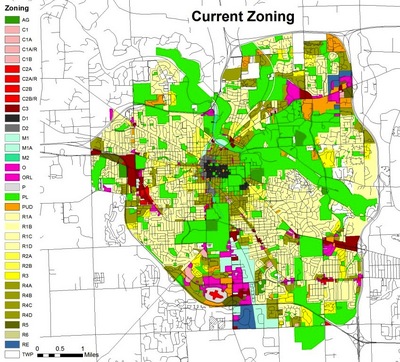Recent solutions in downtown development show not only contextual problems, such as insensitivity to concerns of neighborhood, but a general lack of architectural imagination. One reason is the rigidity which results from excessive reliance on zoning. There are better ways to urban planning. Note the word “process” in the title of my remarks. We lack two basic assets: preliminary, documented visions for all sites under consideration and flexibility to change such visions into alternatives when new understanding of the particular circumstances arises.

The current zoning map of Ann Arbor.
With these entities synergized, development with continuity can be initiated which is much preferable to what we experience now with at hoc confrontations. Consider the following scenario.
- The City with input from interested parties identifies all potential sites for urban redevelopment.
- Each site is developed toward preliminary design by architecture and planning student teams in their design classes with input by professionals in addition to their teachers. During the 16 years of my teaching here I used often downtown sites. Many of the solutions which we came up with were superior to what exists now on some of these sites or is presently proposed for them.
- Why? We had usually several projects for the same site with various perspectives for development and made adjustments according to dialectic and sympathetic argumentation. We could change the ‘rules of the game’ somewhat when we felt that circumstances favored a change in zoning requirements.
- The proposals are exhibited in suitable spaces (libraries, warehouse spaces, etc.) for further discussions and input by professionals and laypeople. The proposals will provide evolving frameworks for particular site developments. All involved will have to agree that participation does not constitute any rights of individuals or entities but brings the proposals into public ownership as contribution to the welfare of the city.
- After each site has been developed and publicly discussed to the point of reasonable consensus, City awards the site ‘preliminary site master plan approval’.
- A small budget is approved by City and funds solicited from the public not for salaries but for expenses of documentation and exhibition of results.
A group of local architects and other professionals recently visited Tubingen, our sister city in Germany. They could see excellent examples of highly flexible urban planning according to site-specific circumstances. Although the background conditions are different, we can learn from some basic principles applied there, and we can find our own approaches derived from them.
My proposal is probably controversial, not least for my own profession. But an approach somewhat like it would provide the opportunity to develop a highly adaptable environment of comprehensive urban planning. The City would retain its powers but could make decisions based on better site related input and on broader consensus because of the many people productively involved before final decisions have to be made.
Kurt Brandle is an Ann Arbor resident and Professor Emeritus of Architecture at the University of Michigan